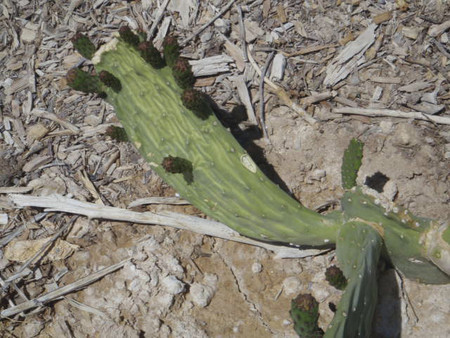Cacti need infrequent but deep waterings

: I bought a Mission cactus last year. The tag said to water it well until it “was established,” but I didn’t really know how much water to give it after that. I looked up Mission cactus on the Internet and most sites said little or no water, or arid dry. It has grown quite a bit since I planted it, and even now has small new growth on a few ends. Lately though it has twists and folds with a yellowish color in the middle of the “hands.” I have no idea whether I am watering it enough or too much as it doesn’t respond much differently. I really like this plant, and it is a focal point when anyone comes through our gate into the courtyard.
A: Mission cactus is basically a beavertail or a nopal-type cactus.
When you are watering a cactus it is important to water it deeply but infrequently. This is what is meant by telling you to water it “well” until it gets established. If, by chance, you interpret that to mean watering frequently with small amounts of water, you run the risk of having it fall over when it gets bigger or possibly killing it.
The basic rule about watering desert plants, and this includes cactus as well as natives coming out of desert areas, is to remember that they flourish when water is available but they also have safety mechanisms that allow them to survive long periods of time between irrigations. So when watering cactus and other plants from desert environments you should be able to manage their growth by managing how frequently they are watered.
The amount of water applied should wet the soil to a depth of at least a foot at each watering. The amount of water to apply is less critical than the frequency of application. I may water a small new cactus or a cactus pad planted as a “start” with about a gallon of water each time. But in the summer, this new cactus may get watered only once every two weeks. Of course as the plant gets bigger, it will require more water applied at each watering. The frequency of application will remain the same.
During the winter, when there is little growth, this same cactus may get watered only once or twice through the entire winter. As we know, cacti are specialized in their ability to store water. Use this trait to your advantage by not watering them as often but applying enough so they can store it.
Many cacti will indicate they need water through the appearance of their “skin.” Their outer surfaces will become slightly wrinkled as the plant loses water or they may have a slight change in color. When producing cactus “vegetable” or fruits you do not want the plant to go this far or it hurts production. But when using cacti as ornamentals it doesn’t hurt the plant at all and can actually slow down its growth, if that is what you want to do.
Symptoms of overwatering your cactus can include the yellowing you are seeing. The other critical component in maintaining your cactus will be to provide exceptional drainage around the roots.
If you want to have even more success with your cactus, success that will make your cactus healthier, use compost in the planting hole at the time of planting and fertilize it once a year.
We grow beavertail or Opuntia cactus at the University of Nevada Cooperative Extension Master Gardeners Orchard in North Las Vegas for fresh vegetable and fruit production. These cacti are watered every other time we water our fruit trees but follow the same fertilizer routine as our orchard fruit trees.
By watering less often we still get lots of new growth that we harvest as vegetable as well as root growth that penetrates the soil deeply. This helps to keep tall cactus upright. If we were to water the cacti as often as we water fruit trees, the cactus would grow at a tremendous rate and become so top heavy and have roots so shallow that the entire plant would fall over due to its own weight or during any good, stiff breeze.
Bob Morris is an associate professor with the University of Nevada Cooperative Extension. Direct gardening questions to the master gardener hot line at 257-5555 or contact Morris by e-mail at morrisr@unce.unr.edu.












